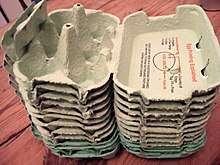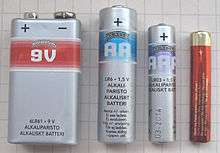Disposable product
A disposable (also called disposable product) is a product designed for a single use after which it is recycled or is disposed as solid waste. The term is also sometimes used for products that may last several months (e.g. disposable air filters) to distinguish from similar products that last indefinitely (e.g. washable air filters). The word "disposables" is not to be confused with the word "consumables", which is widely used in the mechanical world. For example, welders consider welding rods, tips, nozzles, gas, etc. to be "consumables", as they last only a certain amount of time before needing to be replaced.

Etymology
"Disposable" is an adjective meaning something not reuseable but is disposed of after use. Many people now use the term as a noun or substantive, i.e. "a disposable" but in reality this is still an adjective as the noun (product, nappy, etc.) is implied. Disposable income is the amount of money left over from one's salary or pay for spending, saving or whatever, after all living costs have been taken out.
Materials
Disposable products are most often made from paper, plastic, cotton, or polystyrene foam. Products made from composite materials such as laminations are difficult to recycle and are more likely to be disposed of at the end of their use.
Examples of disposables
Kitchen and dining products
Packaging
Packages are usually intended for a single use. The waste hierarchy call for minimization of materials. Many package forms and materials are suited to recycling although the actual recycling percentages are relatively low in many regions. Reuse and repurposing of packaging is increasing but eventually, containers will be recycled, composted, incinerated, or landfilled.
There are many container forms such as boxes, bottles, jars, bags, etc. Materials include paper, plastics, metals, fabrics, composites, etc.
Food service industry disposables
.jpg)
In 2002, Taiwan began taking action to reduce the use of disposable tableware at institutions and businesses, and to reduce the use of plastic bags. Yearly, the nation of 17.7 million people was producing 59,000 tons of disposable tableware waste and 105,000 tons of waste plastic bags, and increasing measures have been taken in the years since then to reduce the amount of waste.[7] In 2013 Taiwan's Environmental Protection Administration (EPA) banned outright the use of disposable tableware in the nation's 968 schools, government agencies and hospitals. The ban is expected to eliminate 2,600 metric tons of waste yearly.[8]
In Germany, Austria, and Switzerland, laws banning use of disposable food and drink containers at large-scale events have been enacted. Such a ban has been in place in Munich, Germany, since 1991, applying to all city facilities and events. This includes events of all sizes, including very large ones (Christmas market, Auer-Dult Faire, Oktoberfest and Munich City Marathon). For small events of a few hundred people, the city has arranged for a corporation offer rental of crockery and dishwasher equipment. In part through this regulation, Munich reduced the waste generated by Oktoberfest, which attracts tens of thousands of people, from 11,000 metric tons in 1990 to 550 tons in 1999.[9]
China produces about 57 billion pairs of single-use chopsticks yearly, of which half are exported. About 45 percent are made from trees – about 3.8 million of them – mainly cotton wood, birch, and spruce, the remainder being made from bamboo. Japan uses about 24 billion pairs of these disposables per year, and globally the use is about 80 billion pairs are thrown away by about 1.4 million people. Reusable chopsticks in restaurants have a lifespan of 130 meals. In Japan, with disposable ones costing about 2 cents and reusable ones costing typically $1.17, the reusables better the $2.60 breakeven cost. Campaigns in several countries to reduce this waste are beginning to have some effect.[10][11]
Medical and hygiene products
Medical and surgical device manufacturers worldwide produce a multitude of items that are intended for one use only.[12] The primary reason is infection control; when an item is used only once it cannot transmit infectious agents to subsequent patients.[13] Manufacturers of any type of medical device are obliged to abide by numerous standards and regulations. ISO 15223: Medical Devices and EN 980 cite that single use instruments or devices be labelled as such on their packaging with a universally recognized symbol to denote "do not re-use", "single use", or "use only once". This symbol is the numeral 2, within a circle with a 45° line through it.
Examples of single use items include:
- Hypodermic needles [14]
- Toilet paper
- Disposable towels, paper towels[15][16]
- Condoms and other contraception products
- Disposable enemas and similar products[17]
- Cotton swabs and pads[18]
- Medical and cleaning gloves
- Medical dust respirators (dust masks)
- Baby and adult diapers, and training pants[19][20][21]
- Shaving razors, safety razors, waxing kits, combs, and other hair control products[22][23][24]
- Toothbrushes, dental floss, and other oral care products
- Hospital aprons [25]
- Disposable panties in postpartum
- Contact lenses [26]
Electronics

- Non-rechargeable batteries are considered hazardous waste and should only be disposed of as such.[27]
- Disposable ink cartridges
- Disposable cameras [28]
- Ecigarette coils/ Disposable tanks/pods
Defense and law enforcement
Other consumer products

- Garbage bags [29]
- Vacuum cleaner bags, water, air, coolant, and other filters
- vacuum cleaners
- Paper currency, withdrawn from circulation when worn
- Ballpoint pens, erasers, and other writing implements[30]
- Movie sets and theater sets
- Gift wrapping paper
- Labels, stickers, and the associated release liners are single use and usually disposed after use.
- Dust respirators (dust masks)
- Aluminum foil
- Drinking straws
See also
References
- Prairie Farmer. Prairie Farmer Publishing Company. 1982. p. 44. Retrieved June 8, 2017.
- NPCS Board of Consultants & Engineers (2014). Disposable Products Manufacturing Handbook. Niir Project. p. 1. ISBN 978-93-81039-32-8. Retrieved March 9, 2017.
- Hill, M.K. (2010). Understanding Environmental Pollution. Cambridge University Press. p. 519. ISBN 978-1-139-48640-8.
- McEachern, D. (2008). Big Green Purse: Use Your Spending Power to Create a Cleaner, Greener World. Penguin Publishing Group. p. pt149. ISBN 978-1-4406-3009-5. Retrieved June 8, 2017.
- Vasile, C.; Zaikov, G.E. (2009). Environmentally Degradable Materials Based on Multicomponent Polymeric Systems. Taylor & Francis. p. 630. ISBN 978-90-04-16410-9.
- "Disposable table cloth: Patent US5084321". Google Books. February 23, 2017. Retrieved March 9, 2017.
- Env. Research Foundation (undated). Taiwan’s Plastics Ban.
- China Post. June 5, 2013. EPA to ban disposable cups from June 1.
- Pre-Waste EU. (undated). Ban on disposable food and drink containers at events in Munich, Germany (Pre-waste factsheet 99) Archived 2014-09-08 at the Wayback Machine
- New York Times. Reus Oct. 24, 2011. Disposable Chopsticks Strip Asian Forests. By Rachel Nuwer.
- Ecopedia. 2013. How Wooden Chopsticks Are Killing Nature. By Alastair Shaw.
- Engineers, N.B.C. (2014). Handbook on Medical and Surgical Disposable Products. Niir Project. p. 3. ISBN 978-93-81039-28-1. Retrieved June 8, 2017.
- Proctor, D.B.; Adams, A.P. (2013). Kinn's The Medical Assistant - E-Book: An Applied Learning Approach. Elsevier Health Sciences. p. 516. ISBN 978-0-323-18781-7. Retrieved June 8, 2017.
- Rice, J. (2002). Medications and Mathematics for the Nurse. Delmar Thomson Learning. p. 148. ISBN 978-0-7668-3080-6. Retrieved June 8, 2017.
- Chissick, S.S.; Derricott, R. (1981). Occupational health and safety management. Properties of materials, safety and environmental factors. J. Wiley. p. 434. ISBN 978-0-471-27646-3. Retrieved June 8, 2017.
- Loux, R. (2008). Easy Green Living: The Ultimate Guide to Simple, Eco-Friendly Choices for You and Your Home. Rodale Books. p. 136. ISBN 978-1-59486-792-7. Retrieved June 8, 2017.
- Rosdahl, C.B.; Kowalski, M.T. (2008). Textbook of Basic Nursing. Lippincott's practical nursing. Lippincott Williams & Wilkins. p. 654. ISBN 978-0-7817-6521-3. Retrieved June 8, 2017.
- Lussi, A. (2006). Dental Erosion: From Diagnosis to Therapy. Monographs in oral science. Karger. p. 113. ISBN 978-3-8055-8097-7. Retrieved June 8, 2017.
- Blatt, H. (2011). America's Environmental Report Card: Are We Making the Grade?. MIT Press. p. 86. ISBN 978-0-262-51591-7. Retrieved June 8, 2017.
- Farage, M.A.; Miller, K.W.; Maibach, H.I. (2009). Textbook of Aging Skin. Textbook of Aging Skin. Springer Berlin Heidelberg. p. 861. ISBN 978-3-540-89655-5. Retrieved June 8, 2017.
- Eisenberg, A.; Murkoff, H.; Hathaway, S. (2009). What to Expect the Toddler Years. Workman Publishing Company, Incorporated. p. 544. ISBN 978-0-7611-5100-5. Retrieved June 8, 2017.
- Thomas, R.J. (1995). New Product Success Stories: Lessons from Leading Innovators. New directions in business. Wiley. p. 255. ISBN 978-0-471-01320-4. Retrieved June 8, 2017.
- Gallant, A.; Gillott, K.; Howard, J. (1993). Principles and Techniques for the Beauty Specialist. Principles and Techniques for the Beauty Specialist. Nelson Thornes Limited. p. 267. ISBN 978-0-7487-1550-3. Retrieved June 8, 2017.
- Husain, A.M.; Sinha, S.R. (2017). Continuous EEG Monitoring: Principles and Practice. Springer International Publishing. p. 600. ISBN 978-3-319-31230-9. Retrieved June 8, 2017.
- Dougherty, L.; Lister, S. (2011). The Royal Marsden Hospital Manual of Clinical Nursing Procedures. Royal Marsden Manual Series. Wiley. p. 99. ISBN 978-1-4443-4387-8. Retrieved June 8, 2017.
- Hom, M.M.; Bruce, A.S. (2006). Manual of Contact Lens Prescribing and Fitting. Butterworth-Heinemann. p. 310. ISBN 978-0-7506-7517-8. Retrieved June 8, 2017.
- Wellington, T. (2009). The Mom's Guide to Growing Your Family Green: Saving the Earth Begins at Home. St. Martin's Press. p. 79. ISBN 978-1-4299-6463-0. Retrieved June 8, 2017.
- Warren, L. (2005). Encyclopedia of Twentieth-Century Photography, 3-Volume Set. Taylor & Francis. p. 220. ISBN 978-1-135-20543-0. Retrieved June 8, 2017.
- Casey, W. (2009). Firsts: Origins of Everyday Things That Changed the World. DK Publishing. p. 89. ISBN 978-1-101-15900-2. Retrieved June 8, 2017.
- Wherry, T.L. (2008). Intellectual Property: Everything the Digital-age Librarian Needs to Know. American Library Association. p. 20. ISBN 978-0-8389-0948-5. Retrieved June 8, 2017.
External links
| Wikimedia Commons has media related to Disposable goods. |
| Look up disposable in Wiktionary, the free dictionary. |
| Look up disposable product in Wiktionary, the free dictionary. |
- How disposable chopsticks are made (video).